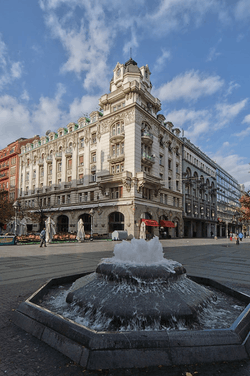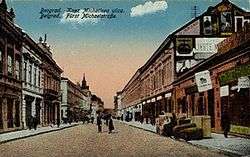Knez Mihailova Street

Knez Mihailova Street or Prince Michael Street, properly Kneza Mihaila (Serbian: Улица Кнез Михаилова (Улица Кнеза Михаила), Ulica Knez Mihailova, (Ulica Kneza Mihaila)) is the main pedestrian and shopping zone in Belgrade, and is protected by law as one of the oldest and most valuable landmarks of the city. Named after Mihailo Obrenović III, Prince of Serbia, it features a number of buildings and mansions built during the late 1870s.
One kilometer long Knez Mihailova Street was in 1979 included on the list of Spatial Cultural-Historical Units of Great Importance, and as such is protected by the Republic of Serbia.[1]
History


The street follows the central grid layout of the Roman city of Singidunum, as one of the main access roads to the city corresponds to the modern street today. During Ottoman occupation, in the first half of the 16th century, the Ottomans repaired the old Roman aqueduct and built a new one along the street with drinking fountains, as the neighborhoods could not develop without the water. They also built gardens and five mosques with adjoining mahalas. When Austrians occupied Belgrade in 1717 they demolished the old houses and mosques and built new buildings.[1]
In the middle of the 19th century, the upper part of the street bordered the garden of Knez Aleksandar Karađorđević. After the implementation of the 1867 city of Belgrade regulation plan by Emilijan Josimović, the street soon gained its current look and architecture. Josimović’s plan marked the beginning of the city’s broader metamorphosis from oriental to the western urbanism.[1] Prior to Josimović, only a short part of what is today Knez Mihailova, called ″Delijska street″, actually existed as a street. Works on construction of the new street began in spring of 1869.[2]
Houses were built there by the most influential and wealthiest families of the Serbian society, most of them merchants. In 1870, two years after the assassination of Prince Mihailo Obrenović, the city authorities officially named the street - Ulica Kneza Mihaila (Prince Michael Street) instead of ″Delijska″. In the late 20th century, from mostly shopping area it evolved into the cultural center of the city.[1]
In 1987 there was a major reconstruction of Knez Mihailova and its transformation into the pedestrian zone. After six months of construction works, the street was open on 20 October 1987. It was paved with the black granite slabs from Jablanica, while a drinking fountain, made of white marble from Venčac, was erected in memory of former Delijska fountain which was further down the street. Previously nonexistent oak avenue through the middle of the street was also introduced, so as vintage looking candelabra which resemble the historical, gas ones. Commemorative plaque for Emilijan Josimović was placed near the “Ruski car” restaurant. During the reconstruction, when the old pavement was removed, an old plaque dedicated to the young volunteers who reconstructed the street in 1949, was found and the two plaques are now exibited next to each other. In 1988 area around the Palace Albania, Hotel Majestic and “Jadran” cinema were also reconstructed, and a new fountain and mini-amphitheatre were placed in the section of the street where it enters the Republic Square. Entire project of the reconstruction was developed by architect and urbanist Branislav Jovin.[1]
Reportedly, as of mid-2010s, much of the street's real estate is owned by Serbian tycoons of the day such as Dragan Đurić, Miroslav Mišković, Miodrag Kostić, Philip Zepter, Radomir Živanić, Vojin Lazarević, Tahir Hasanović, and Radivoje Dražević and it houses their respective business holdings.[3]

Famous buildings
- Srpska Kruna Hotel, located at 56 Knez Mihailova Street, was built in 1869 in the style of romanticism. At the time it was considered Belgrade's most modern hotel. Between 1945 and 1970 the National Library of Serbia was located in this building. Today, the building houses the City of Belgrade library.
- Marko Stojanović's house, 53-55 Knez Mihailova Street, was built in 1889 as a private home of lawyer Marko Stojanović, in the renaissance style. The Academy of Fine Arts, established in 1937, used to be in the building but now the Gallery of the Academy is located there.
- Block of private homes, 46, 48 and 50 Knez Mihailova Street, built in the 1870s, represented the beginning of discontinuity with traditional "Balkan" architecture. Each of the three buildings are shaped in the same manner, a transitional style from romantism to renaissance. The block consists of three buildings:
- Hristina Kumanudi's house, located at 50 Knez Mihailova Street, was built in 1870 as a corner building at the intersection of Kneza Mihaila and Dubrovačka (later renamed Kralja Petra Street) streets by the Serbian merchant and banker of Greek origin Jovan Kumanudi who was also a prominent real estate investor and developer. Before it got built, an existing one-story house at the spot (Jovan Kumanudi's private residence where he also had a shop) got demolished. Kumanudi named the new building after his wife Hrisanta aka Hristina. For a certain period in the late 19th century, the newly erected building housed the French-Serbian Bank, and later the consulates of Belgium and Great Britain. The building was later purchased by Nikola D. Kiki (1841-1918), a Belgrade merchant of Aromanian origin. After his death, in his testament, he signed the building (along with two other city properties) over to the organization named Beogradska trgovačka omladina (Belgrade Merchant Youth) under conditions that they use the funds generated by the three properties to set up a hospital named The Nikola and Evgenija Kiki Endowment, which Kiki envisioned would provide medical help and services to poor and downtrodden merchants. Between 1937 and 1940, a hospital was built at 9 Zvečanska Street.
- Kristina Mehana, located at 48 Knez Mihailova Street, built in 1869 as an administrative-commercial building in which Krstić brothers opened a hotel under the same name, and where meetings of the Belgrade City Assembly took place until the construction of the Assembly's own building. Today, the building houses the offices of Serbian Renewal Movement (SPO), Mona clothing store, Plato bookstore, and since 2004 Via del Gusto restaurant.
- Veljko Savić's house, located at 46 Knez Mihailova Street, built in 1869 as a residential house with shops. It underwent many changes from its original look.
- The Serbian Academy of Sciences and Arts' building, located at 35 Knez Mihailova Street, built from 1923 to 1924 according to the 1912 plans by Dragutin Đorđević and Andra Stevanović, in academic style with elements of secession. The building houses the Academy's library, one of the richest in Belgrade, as well as the Academy's archives containing numerous materials about the Serbian history, and furthermore on the ground floor — the Academy's gallery along with a lecture hall, bookstore, and antique shop.
- Nikola Spasić Endowment building, 33 Knez Mihailova Street, built in 1889, by the designs of the architect Konstantin Jovanović in the renaissance style, as a residential house of Belgrade merchant Nikola Spasić (1840-1916).
- Nikola Spasić Passage, 19 Knez Mihailova Street, built in 1912 in recession style.
- Grčka kraljica (Greek Queen) coffee shop, 51 Knez Mihailova Street, built in 1835 in style of academism. One of the oldest preserved buildings in Belgrade's old core, it originally housed an inn named Despotov Han until Jovan Kumanudi purchased it and changed its name to Kod Grčke kraljice (Greek Queen's).
- Ruski car (Russian Emperor) caffe & restaurant, angle of Knez Mihailova and Obilićev Venac streets built in 1926 in the late Art Nouveau and early Art Deco styles.
- Hotel Russia, 38 Knez Mihailova Street, built in 1870 and annexed in 1920. Today it houses business offices of the "Rudnap" company.
Today

Knez Mihailova is a common meeting point for Belgraders. The street has been named one of the most beautiful pedestrian zones in South East Europe and is a constant buzz of people and tourists. Thousands of people stroll along the street every day as it is the shortest path from Terazije to Kalemegdan park and fortress.
The street is home to Serbian Academy of Sciences and Arts (SANU), Instituto Cervantes, Goethe-Institut, Alliance française, as well as many other leading shops and several cafes.

In December 2006, BusinessWeek magazine included the street as one of Europe's notable Christmas shopping sites.[4] One can find international clothing brands such as Mango, Zara and Zara men, Gap, Nike men and women, Replay, Diesel, Terranova, Sephora, New Look, Swarovski, Cesare Paciotti, Tally Weijl, Miss Sixty, Bata, Bally, Aldo, Adidas, Vapiano, Monsoon Accessorize and many more shops.
Furthermore, the representative offices of various airlines such as Aeroflot, FlyDubai, Emirates Airline, Qantas, Turkish Airlines, Qatar Airways, Ethiopian Airways, Singapore Airlines and Air France are located in Knez Mihailova.
In terms of real estate value, the property in and around Knez Mihailova Street is among the most expensive in Belgrade. The latest confirmation of this occurred in late November 2007 when the 485m2 parcel belonging to state owned company Jugoexport was sold for €15 million, which works out to some €32,000 per square meter (~ $ 35,741 as of August 2016 rates).[5]
Near the end of street, between Knez Mihailova and Uzun Mirkova, a large complex Rajićeva shopping mall is being constructed. It was the location of the house of politician Toma Vučić Perišić. It was demolished in 1950 and the trolleybus roundabout was built, named Rajićeva, after the street. In 2000 an architectural design competition for this location was announced and the winning project was the one by Milan and Vladimir Lojanica. In 2003 the trolleybuses were removed from the location and in 2009 the government's permit for construction was granted. The construction itself was troubled and long. Fellow architects were mostly against the project. Zoran Manević, former president of the Club of Architects, called it a "monstrosity" while member of the Academy of Architecture, Branko Bojović, said there are many cultural issues why it shouldn't be built, naming just one of them, the Roman remains in this entire section of Belgrade, which are shallow and conserved under the ground. Another problem was the restitution as many objects were confiscated by the Yugoslav Communist authorities after the World War II. The construction dragged on for years. Israel investor, "ABD", daughter company of "Ashtrom", cited the reasons for that as the long and complicated process of obtaining permits, unregulated property ownership, archaeological explorations and financial problems due to the global economic crisis. The complex consists of the shopping mall, the first in downtown Belgrade, with 15,300 m2 (165,000 sq ft), which is scheduled to open on 14 September 2017. There is also an underground garage with 450 parking spots. Much larger section, a luxurious hotel with 60,000 m2 (650,000 sq ft) should open in January 2018.[6][7]
See also
- Belgrade
- Mihailo Obrenović III, Prince of Serbia
- Singidunum
- Spatial Cultural-Historical Units of Great Importance
| Wikimedia Commons has media related to Knez_Mihailova. |
References
- 1 2 3 4 5 "Pešačko carstvo od trideset leta".
- ↑ "Iz Starog Beograda – Knez Mihailova ulica (reprint from 11 December 1966)", Politika (in Serbian), 11 December 2016
- ↑ Oni su vlasnici Knez Mihailove;Blic, 29 June 2014
- ↑ Dan Carlin. "Christmas Lights Up European Shopping". Archived from the original on 2008-01-28.
- ↑ Kvadrat lokala "Jugoeksporta" prodat za 32.000 evra, November 29, 2007 Archived January 17, 2008, at the Wayback Machine.
- ↑ J.V. (13 May 2004). ""Slučaj Rajićeva", srećom bez žrtava" (in Serbian). Glas Javnosti.
- ↑ Daliborka Mučibabić (29 July 2017), "Prvi šoping mol na kraju Knez Mihailove - 14. septembra", Politika (in Serbian), p. 15
External links
Route map: Google
